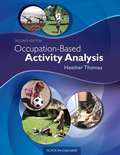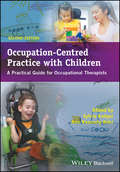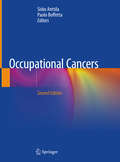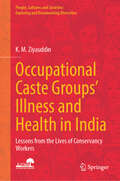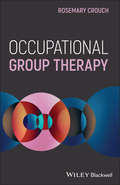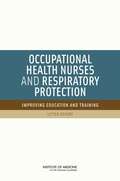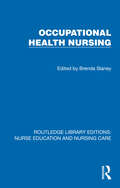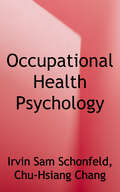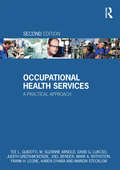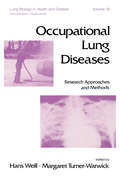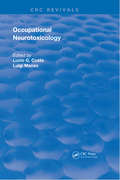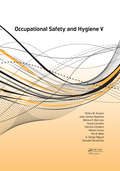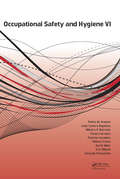- Table View
- List View
Occupation-Based Activity Analysis
by Heather ThomasOccupational therapists use occupations and activities as not just a goal, but also as a treatment medium, therefore, they must understand both the uniqueness of a client’s occupations and how an activity can be used therapeutically. To analyze the complexity of an occupation takes much more depth of understanding of the person engaging in it, his or her environment, and the uniqueness of the occupation a person has chosen. <p><p> The new Second Edition of Occupation-Based Activity Analysis continues the tradition of teaching students and clinicians the process of conducting activity analyses and occupation-based activity analyses. <p> Dr. Heather Thomas has updated Occupation-Based Activity Analysis, Second Edition to reflect the significant changes made to the activity analysis process and terminology in the Occupational Therapy Practice Framework, Third Edition. As in an activity analysis, occupation-based activity analysis looks at what is required for full participation, yet goes beyond analyzing the activity; it looks at what it means for the person engaging in it and how and where it is performed by that person. <p> Inside Occupation-Based Activity Analysis, Second Edition, each chapter is dedicated to a component of the activity analysis process and corresponding section of the Framework. Chapters have been restructured based on a greater emphasis on occupation-based activity analysis. From start to finish, readers are guided through identifying the occupation, sequence and timing, objects and properties, space and social demands, body functions, and structures and performance skills required.
Occupation-Centred Practice with Children: A Practical Guide for Occupational Therapists
by Sylvia Rodger Ann Kennedy-BehrOccupation-Centred Practice with Children remains the only occupational therapy book which supports the development and implementation of occupation-centred practice with children. Drawing on the latest occupational therapy theory and research, this new edition has been fully updated throughout, and includes new chapters on occupational transitions for children and young people, assessing children's occupations and participation, intervention within schools, the arts and children's occupational opportunities, as well as using animals to support children's occupational engagement. Key features: Written by an international expert team of contributors. Each chapter begins with preliminary questions to assist with consideration of current knowledge and ends with reflection questions to allow revision of key content to support independent learning. Highly practical, with a range of case studies, key point summaries, reflective questions, best-practice guidelines and a range of tools, interventions and techniques to aid applications to practice. A new appendix outlining all the assessments referred to in the book. Occupation-Centred Practice with Children is a practical, theoretically grounded and evidence-based guide to contemporary occupational therapy practice, and is important reading for all occupational therapy students and therapists wishing to make a real difference to children and their families' lives.
Occupational Analysis And Group Process
by Jane Clifford O'Brien Jean W. SolomonLearn how to analyze client needs and use group therapy for effective interventions! Occupational Analysis and Group Process, 2nd Edition provides practical information on two key components of occupational therapy practice, helping you understand how to intervene with a variety of clients. Using case scenarios and clinical examples, this book provides strategies and guidelines for analyzing functional tasks for clients from children to adolescents to adults. It guides you through every step of the group process, including group leadership, communication within the group, and group interventions. Written by noted OT educators Jane Clifford O’Brien and Jean W. Solomon, this book provides a solid foundation for intervention planning.
Occupational Cancers
by Paolo Boffetta Sisko AnttilaThis book is a comprehensive guide to occupational factors of malignant diseases. It discusses potentially work-related malignancies, in the context of exposure assessment, specific clinical and pathological features of occupational cancer and biomarkers of exposure and disease. Epidemiological data about risk ratios of the cancer in question are reviewed for various occupations and with exposure to specific carcinogens, carcinogenic mechanisms, host susceptibility factors (genetic and other) and other environmental and life-style risk factors. Aspects such as surveillance of workers exposed to carcinogens and strategies for prevention of occupational cancer are also discussed. Occupational Cancers is aimed at oncologists, pathologists, residents in training, clinical researchers, clinicians in occupational health, epidemiologists, pulmonologists, lawyers and public health officials.
Occupational Cancers: Clinical And Pathological Features, Assessment And Diagnosis (International Agency For Research On Cancer Scientific Publications #No.129)
by Paolo Boffetta Sisko AnttilaThis revised and updated new edition of a successful book is a multidisciplinary, comprehensive guide to occupational factors of malignant diseases.Building on the first edition, new research discoveries and their consequences in our understanding on carcinogenic mechanisms, diagnosis and attribution of occupational cancers are discussed. Examples of such discoveries are germline and acquired mutations of BAP1 in malignant mesothelioma, which have led to changes in diagnostic criteria, and carcinogen-specific genetic and epigenetic alterations in lung cancer. There are several new chapters, including gastrointestinal cancers, epidemiology of lung cancer, cancer of thyroid, and the role of primary health care in occupational cancer control.Occupational Cancers is aimed at experienced and trainee oncologists, pathologists, clinicians in occupational health, and pulmonologists, as well as epidemiologists, clinical researchers, lawyers and public health officials.
Occupational Caste Groups' Illness and Health in India: Lessons from the Lives of Conservancy Workers (People, Cultures and Societies: Exploring and Documenting Diversities)
by K. M. ZiyauddinThis book examines the status of public health care services to marginalised and disadvantaged populations in India, sociological perspectives on illness and health, and manifest perceptions of illness and health. It emphasizes the need to address the longstanding issue of discriminatory practices towards specific caste-based occupational communities, such as the Hadis. It provides in-depth insights into the various stages of health-seeking behavior, the significance of healers within the social fabric of the Hadi caste, and the complex interplay of agencies and institutions that shape the perceptions of conservancy and menial workers regarding illness and health. The chapters unravel layers and sites of agencies and institutions shaping the perceptions of conservancy and menial workers about illness and health. It offers an avenue of research to readers and scholars interested in understanding perceptions of illness and health among caste-based occupational groups in India with the help of intensive fieldwork data. This book is intended for a diverse audience, including policymakers, urban development practitioners, ethnographers, public health academics, anthropologists and sociologists.
Occupational Emergency Medicine
by Michael GreenbergWith a large proportion of emergency admissions due to occupational health problems, the effect this can have on your practice cannot be ignored. Owing to the shortage of occupational physicians and limited worker access to health care, the diagnosis and treatment of occupational diseases rely increasingly on the emergency physician. Apart from extra paperwork, owing to the extra legal and administrative regulations, a lack of knowledge of occupational medicine can risk a missed diagnosis. This burden of work means occupational disorders impact the whole of the emergency department. Michael Greenberg addresses your questions and concerns about the management of these patients: from triage to discharge, and beyond for all work-place injuries or disorders, whether office-based, agricultural or industrial and their employment regulations Occupational Emergency Medicine is an essential reference for emergency physicians and trainees, featuring comprehensive information on legal issues involving the physician, and advice on managing occupational health admissions.
Occupational Group Therapy
by Rosemary CrouchOccupational Group Therapy helps group leaders achieve a higher and more dynamic level of therapeutic intervention, gain a better understanding of foundational concepts and research, and utilise active techniques that have meaningful and lasting effects on their clients. This practical guide encourages readers to use and develop their skills creatively in a range of interventions, including hospital-based work with acutely ill clients, physical acute care, and rehabilitation. The text presents both the theoretical background and practical applications of occupational group therapy: core skills and concepts, styles of group leadership, clinical and ethical reasoning, and different models of therapy such as the functional group model, the model of human occupation (MOHO), and the occupational therapy interactive group model (OTIGM), alongside warm-up and ice-breaker techniques, role-play exercises, assertiveness and social skills training strategies, guidance on using psychodrama and the therapeutic spiral model (TSM) in group settings, and more. Develops the skills and self-confidence occupational therapists need to be effective group leaders Covers the functional and performance aspects necessary for occupational therapy intervention, including client handling, and structuring and communication skills Discusses new ways of addressing common concerns and issues in various intervention settings Offers ideas and techniques for using higher-level interventions, such as psychodrama and the Therapeutic Spiral model Helps readers to design effective group experiences that allow their clients to “work on themselves” both inside and outside of the group Written by an esteemed expert with decades of practical experience in the field, with a chapter from Louise Fouché, an accomplished occupational group therapist and developer of OTIGM, and foreword by Professor Emerita Sharon Brintnell, former President of World Federation of Occupational Therapy (WFOT): Occupational Group Therapy is a must-have teaching manual and guide for undergraduate and post-graduate occupational therapy students, and for practitioners looking to increase their use of group work as a therapeutic intervention.
Occupational Hazards
by Elanah UretskyDoing business in China can be hazardous to your health. Occupational Hazards follows a group of Chinese businessmen and government officials as they conduct business in Beijing and western Yunnan Province, exposing webs of informal networks that help businessmen access political favors. These networks are built over liquor, cigarettes, food, and sex, turning risky behaviors into occupational hazards. Elanah Uretsky's ethnography follows these powerful men and their vulnerabilities to China's burgeoning epidemics of sexually transmitted infections (STIs) and HIV/AIDS. Examining the relationship between elite masculine networking practices and vulnerability to HIV infection, Occupational Hazards includes the stories of countless government officials and businessmen who regularly visit commercial sex workers but resist HIV testing for fear of threatening their economic and political status. Their fate is further complicated by a political system that cannot publicly acknowledge such risk and by authoritative international paradigms that limit the reach of public health interventions. Ultimately, Uretsky offers insights into how complex socio-cultural and politico-economic negotiations affect the development and administration of China's HIV epidemic.
Occupational Health Ethics: From Theory to Practice
by Jacques TaminThis book provides occupational health (OH) professionals with a theoretical basis for addressing the ethical issues that they confront in their practice. There is often a lack of in-depth moral analysis of the issues that OH practitioners face on a daily basis. The ICOH Code of Ethics sets out the important principles that guide OH practice. This book builds on these core principles, starting from an application of moral theories in the OH context and illustrating how ethical conflicts could be resolved, by carrying out ethical analyses of several case studies. In this way, it aims to link ethical theory to OH practice.
Occupational Health Nurses and Respiratory Protection: Letter Report
by Linda Hawes CleverOccupational health nurses (OHNs) are front-line advocates for preventing illness and injury and protecting health in a variety of workplace settings, including the areas of agriculture, construction, health care, manufacturing, and public safety. OHNs need education and training in respiratory protection in order to ensure both their safety and the safety of America's workers. At the request of the National Personal Protective Technology Laboratory of the National Institute for Occupational Safety and Health, the Institute of Medicine (IOM) examined existing respiratory protection curricula and made recommendations to improve education and training in respiratory protection for OHNs. The IOM finds that current respiratory protection education receives varying amounts of dedicated time and resources and is taught using a variety of approaches. Several recommendations are made to improve the respiratory protection education and training of OHNs.
Occupational Health Nursing (Routledge Library Editions: Nurse Education and Nursing Care)
by Brenda SlaneyWhen this book was originally published in 1980, the speciality of occupational health nursing was only just beginning to be recognised by the nursing profession and the public although nurses had been doing the job for over one hundred years. One of the reasons for this may well have been the lack of nursing literature dealing with the subject. This book, written by tutors of Occupational Health Nursing Certificate Courses and practitioners in industry considers topics and concepts that give the specialism its unique character.
Occupational Health Psychology
by Irvin Schonfeld Chu-Hsiang ChangThis comprehensive text for advanced undergraduate and graduate occupational health psychology (OHP) survey courses draws from the domains of psychology, public health, preventive medicine, nursing, industrial engineering, law, and epidemiology to focus on the theory and practice of protecting and promoting the health, well-being, and safety of individuals in the workplace and improving the quality of work life. <p><p>The book will also appeal to anyone who is concerned with the corrosive effects of job stress. The text addresses key psychosocial work issues that are often related to mental and physical health problems, including psychological distress, burnout, depression, accidental injury, obesity, and cardiovascular disease. It examines leadership styles as they impact organizational culture and provides specific recommendations for reducing employee-related stress through improved leader practices. Also addressed is the relationship between adverse psychosocial working conditions and harmful health behaviors, along with interventions aimed at improving the work environment and maximizing effectiveness. Additionally, the book discusses how scientists and practitioners in OHP conduct research and other important concerns such as workplace violence, work and life balance, and safety. The book reinforces learning with key concepts and findings, highlight tables containing intriguing examples of research and current controversies, and chapter summaries.
Occupational Health Services: A Practical Approach
by Tee L. Guidotti Mark A. Rothstein M. Suzanne Arnold David G. Lukcso Judith Green-McKenzie Joel Bender Frank H. Leone Karen O'Hara Marion StecklowWorkers and their families, employers, and society as a whole benefit when providers deliver the best quality of care to injured workers and when they know how to provide effective services for both prevention and fitness for duty and understand why, instead of just following regulations. Designed for professionals who deliver, manage, and hold oversight responsibility for occupational health in an organization or in the community, Occupational Health Services guides the busy practitioner and clinic manager in setting up, running, and improving healthcare services for the prevention, diagnosis, treatment, and occupational management of work-related health issues. The text covers: an overview of occupational health care in the US and Canada: how it is organized, who pays for what, how it is regulated, and how workers’ compensation works how occupational health services are managed in practice, whether within a company, as a global network, in a hospital or medical group practice, as a free-standing clinic, or following other models management of core services, including recordkeeping, marketing, service delivery options, staff recruitment and evaluation, and program evaluation depth and detail on specific services, including clinical service delivery for injured workers, periodic health surveillance, impairment assessment, fitness for duty, alcohol and drug testing, employee assistance, mental health, health promotion, emergency management, global health management, and medico-legal services. This highly focused and relevant combined handbook and textbook is aimed at improving the provision of care and health protection for workers and will be of use to both managers and health practitioners from a range of backgrounds, including but not limited to medicine, nursing, health services administration, and physical therapy.
Occupational Health Services: A Practical Approach
by Tee L. Guidotti M. Suzanne Arnold Paula LantsbergerThe new edition of Occupational Health Services provides an essential guide in setting up, running, and improving healthcare services either in an organization or within the community. The book offers an invaluable toolkit for the prevention, diagnosis, treatment, and occupational management of work-related health issues.The text covers: An overview of occupational health care in the United States and Canada – how it is organized, who pays for what, how it is regulated, and how workers’ compensation works. It explains how occupational health services are managed in practice, whether within a company, as a global network, in a hospital or medical group practice, as a free-standing clinic, or following other models. The management of core services, including record-keeping, marketing, service delivery options, staff recruitment and evaluation, and program evaluation. It provides details on specific services such as clinical service delivery for injured workers, periodic health surveillance, impairment assessment, fitness for duty, alcohol and drug testing, employee assistance, mental health, health promotion, emergency management, global health management, and medicolegal services. Thoroughly updated throughout and including a new chapter on Consulting, this unique book will be a key reference work for managers and health practitioners from a range of backgrounds, including but not limited to medicine, nursing, health services administration, and physical therapy, as well as students training in these fields.
Occupational Health and Rehabilitation: New Approaches for Maintaining Work Ability in the Workplace (FOM-Edition)
by Thomas Johansen Winand H. DittrichSustaining a healthy and productive work environment for employees with health issues and work disabilities or those returning to work after sick leave may present a challenge to employers. This publication offers unique insights into occupational health and rehabilitation, covering international perspectives as well as a variety of health-related disciplines. Policymakers, employers, employees, researchers and students will find new approaches to questions of how to maintain work ability and health in the workplace: Which motives influence strategic planning in the healthcare and employment sector? How can the return of employees after sick leave be facilitated? How best to implement innovations while keeping the workplace safe and healthy? And how does occupational rehabilitation benefit from evidence-based knowledge transfer?Contents• Work Ability and Work Disability• Return to Work• Work and Health• Work and Innovation
Occupational Health and Safety in the Care and Use of Research Animals
by Committee on Occupational Safety Health in Research Animal FacilitiesMuch has been written about the care of research animals. Yet little guidance has appeared on protecting the health and safety of the people who care for or use these animals.This book, an implementation handbook and companion to Guide For the Care and Use of Laboratory Animals, identifies principles for building a program and discusses the accountability of institutional leaders, managers, and employees for a program's success. It provides a detailed description of risks-- physical and chemical hazards, allergens and zoonoses, and hazards from experiments--which will serve as a continuing reference for the laboratory.The book offers specific recommendations for controlling risk through administrative procedures, facility design, engineering controls, and periodic evaluations. The volume focuses on the worker, with detailed discussions of work practices, the use of personal protective gear, and the development of an emergency response plan.This handbook will be invaluable to administrators, researchers, and employees in any animal research facility. It will also be of interest to personnel in zoos, animal shelters, and veterinary facilities.
Occupational Health: Pocket Consultant (Pocket Consultant #4)
by Kerry Gardiner Tar-Ching Aw J. M. HarringtonOffering a balance of theory and practice, with guides for further reading, this is a clinical guide for the practitioner in the widest sense: physicians, nurses, occupational hygienists, safety officers, environmental, health officers and personnel managers. With coverage of both medicine and hygiene, and including sections on OH law, it is a primer for appropriate courses and provides all that the interested medical student would need to know.
Occupational Hearing Loss, Fourth Edition
by Robert Thayer Sataloff Pamela C. RoehmNow in its fourth edition, Occupational Hearing Loss delivers a complete overview of the hazards of occupational noise exposure, causes of hearing loss, testing of hearing, criteria to distinguish occupational hearing loss, and more. The book emphasizes medical and societal factors in its coverage of topics such as audiometry and who should do it, evoked response testing, and conductive and sensorineural hearing loss, as well as mixed, central, and functional hearing loss.Brought together by experienced practitioners and written by experts with depth and experience in the field, this book is written clearly in language accessible to non-medical personnel. No other book available has the breadth, practical detail, or comprehensive scope. A unique compendium of information about specific problems of occupational hearing loss and hearing conservation, the book is both a balanced reference and an easy-to-use guide to protecting the hearing of industrial workers.This title is an ideal read for any student or professional occupational physician, audiologist, health and safety engineer, industrial hygienist, and otolaryngologist.
Occupational Lung Diseases: Research Approaches and Methods
by H. WeillThis book discriminates and emphasizes approaches that are likely to be productive in terms of understanding the causation and mechanisms of occupational lung diseases. It benefits research academicians in the field of lung diseases, and government and public health authorities.
Occupational Neurotoxicology (Routledge Revivals)
by Lucio G. Costa Luigi ManzoFirst published in 1988, many chemical compounds present in workplace settings can produce a number of impairments in the human nervous system. As the situations in which neurotoxic agents have been recognized in exposed workers has grown, so has the importance of occupational neurotoxicology as a specialty. Addressing some of the most vital concerns in the field, Occupational Neurotoxicology discusses: Neurotoxic agents commonly encountered in the workplace Signs and symptoms of neurotoxicity and of the factors affecting neurotoxic effects Biological monitoring and the use of biomarkers Epidemiological methods and clinical approaches to occupational neurotoxicology The analysis of behavioral, electrophysiological, and imaging techniques in the diagnosis of neurotoxicity Occupational neurotoxicity in developing countries The evaluation and management of occupational illnesses due to neurotoxicityOccupational Neurotoxicology concisely covers important facts on the adverse effects of chemical, biological, and physical agents that can impair or alter the structure of the nervous system. Professionals and researchers in the fields of occupational medicine, toxicology, epidemiology, neurology, industrial hygiene, and psychology will all find relevant information on the health problems that can occur from exposure to neurotoxicants.
Occupational Performance Coaching: A Manual for Practitioners and Researchers
by Jenny Ziviani Fiona Graham Ann Kennedy-BehrThis book presents a definitive guide to understanding, applying, and teaching Occupational Performance Coaching (OPC). Grounded in principles of occupational therapy, person-centredness, and interprofessional frameworks of health and disability, this book will be of interest across health and rehabilitation professions. Supporting people affected by disability to do well and live the life they want is the ultimate outcome of all rehabilitation professionals, no matter where on the lifespan our clients sit. Coaching is increasingly recognised as highly effective in achieving this aim. This accessible manual provides case examples related to diverse health conditions alongside practitioner reflections. Uniquely, this manual presents coaching methods designed specifically for the rehabilitation environment. This book is a manual for practitioners, researchers, students, and lecturers interested in gaining a robust understanding of OPC methods, theoretical basis, and implementation. An e-Resource linked to the book provides access to video demonstrations, a podcast from Dr Graham, and downloadable materials including a self-assessment of OPC skills (OPC Fidelity Measure), templates for clinical work, and teaching presentation material.
Occupational Safety and Hygiene V: Selected papers from the International Symposium on Occupational Safety and Hygiene (SHO 2017), April 10-11, 2017, Guimarães, Portugal
by Pedro M. Arezes João Santos Baptista Rui B. Melo Mónica P. Barroso, Paula Carneiro, Patrício Cordeiro & Nélson Costa A. Sérgio Miguel & Gonçalo PerestreloOccupational Safety and Hygiene V contains selected contributions from the International Symposium on Occupational Safety and Hygiene (SHO 2017, 10-11 April 2017, Guimarães, Portugal). The contributions focus on a wide range of topics, including: - occupational safety- risk assessment- safety management- ergonomics- management systems- environmental ergonomics- physical environments- construction safety, and- human factors Occupational Safety and Hygiene V is mainly based on research carried out at universities and other research institutions, but also includes practical studies developed by OHS Practitioners within companies. Accordingly, this book will be a helpful text to get acquainted with the state-of-the-art in research in these domains, as well as with some practical tools and approaches that are currently used by OHS professionals worldwide.
Occupational Safety and Hygiene VI: Book chapters from the 6th International Symposium on Occupation Safety and Hygiene (SHO 2018), March 26-27, 2018, Guimarães, Portugal
by Pedro M. Arezes João Santos Baptista Monica P. Barroso Paula Carneiro Patrício Cordeiro Nelson Costa Rui B. Melo A. Sergio Miguel Gonçalo PerestreloOccupational Safety and Hygiene VI collects recent papers of selected authors from 21 countries in the domain of occupational safety and hygiene (OSH). The contributions cover a wide range of topics, including:- Occupational safety- Risk assessment- Safety management- Ergonomics- Management systems- Environmental ergonomics- Physical environment- Construction safety, and- Human factors Occupational Safety and Hygiene VI represents the state-of-the-art on the above mentioned domains, and is based on research carried out at universities and other research institutions. Some contributions focus more on practical case studies developed by OSH practitioners within their own companies. Hence, the book provides practical tools and approaches currently used by OHS practitioners in a global context.
Occupational Science for Occupational Therapy
by Doris PierceOccupational Science for Occupational Therapyarticulates how occupational science research produces unique insights into occupation and increases the effectiveness of occupational therapy interventions. This text illustrates the four key types of knowledge now being researched in occupational science: descriptive, relational, predictive, and prescriptive. This text also offers a comprehensive review of occupational science’s history of emergence from the needs and interests of occupational therapy, conflicting origins and intents, and ongoing development as a discipline within academia. In Occupational Science for Occupational Therapy, Dr. Doris Pierce and an outstanding group of occupational scientists explain how their discoveries build the science and support practice. A rich variety of methods and perspectives mark the work of these career scientists as they respond to the knowledge base needs of occupational therapy. This fully evidence-based text also brings the research experience alive for occupational therapy students, describing the passions, challenges, and choices that are the reality of research as an occupation. All research chapters discuss how findings build both science and practice, including learning supports in which students can try out research activities, explore assessment, or develop interventions. Most importantly, Occupational Science for Occupational Therapyprovides new and experienced practitioners a thorough exploration of the latest research in occupation-based practice.Occupational Science for Occupational Therapy synthesizes key works by occupational scientists, including a foreword by Dr. Elizabeth Yerxa, founder of the science. Occupational therapy and occupational science students, practitioners, and faculty will especially appreciate this book’s comprehensive coverage of work by current leaders of research on occupation-based practice.
